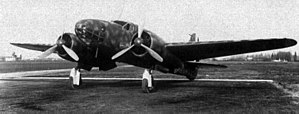Caproni Ca.310
| Ca.310 | |
|---|---|
 |
|
| Caproni-Begamaschi Ca.310 | |
| Role | Reconnaissance |
| Manufacturer | Caproni |
| Designer | Cesare Pallavicino |
| First flight | April 1937 |
| Introduction | 1938 |
| Retired | 1948 |
| Primary users |
Regia Aeronautica Hungarian Air Force Royal Norwegian Air Force Air Force of Peru |
| Number built | 312 |
| Variants |
Caproni Ca.313 Caproni Ca.311 |
The Caproni Ca.310 Libeccio (Italian: southwest wind) was an Italian monoplane, twin-engine reconnaissance aircraft used in World War II. Derived from the similar Ca.309, it had its combat debut during the Spanish Civil War and took part in the earlier phases of World War II in Libya. Some were used in attack groups as a temporary replacement for the unsatisfactory Breda Ba.65. The last Ca.310 was retired by the Italian Air Force in 1948.
The Ca.310 was designed as a low-wing monoplane reconnaissance/bomber, being essentially a version of the semi-military Ca.309 with retractable landing gear and uprated engines. The fuselage was of welded steel tube construction with a covering of light alloy panels and fabric, while the empennage/tail unit was of wooden construction with plywood skin on its fixed portions and fabric covering on control surfaces.
Above the fuselage, mounted in line with the wing trailing edges was a manually operated dorsal turret armed with a single rifle-caliber (7.7 mm/0.303 in) Breda-SAFAT machine gun.
Caproni pinned great hopes on the Ca. 310's effectiveness as a combat aircraft, only to be dashed when its performance fell short of expectations. This lack of performance resulted in both Norway and Hungary being disappointed with the export models they received in 1938. The Ca.310 had been evaluated by the Regia Aeronautica (Italian Air Force) which ordered a small batch. A unit of 16 aircraft was sent to Spain in July 1938 for operational trials as a reconnaissance/bomber by the Italian expeditionary force operating alongside the Nationalist insurgents in the Spanish Civil War.
...
Wikipedia
